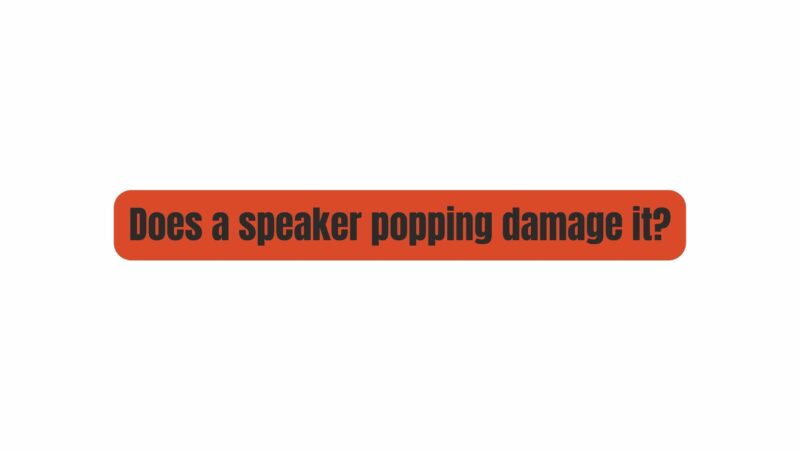Speakers, those humble yet indispensable devices, are our gateways to the world of sound. They breathe life into our favorite music, movies, and podcasts. However, as we indulge in the auditory symphony they create, a concern often arises: the occasional, jarring popping sound that emanates from our speakers. This curious phenomenon raises a significant question among audio enthusiasts: does speaker popping damage these cherished audio companions? In this comprehensive article, we aim to dissect the subject, exploring the potential consequences of speaker popping, the factors that contribute to damage, and practical strategies to prevent and mitigate harm.
Understanding Speaker Popping
Before we dive into the consequences of speaker popping, it’s essential to understand what this phenomenon entails. A speaker is essentially a transducer, a device that transforms electrical signals (audio signals) into mechanical vibrations (sound waves). This process relies on intricate components like diaphragms, voice coils, magnets, and amplifiers.
Now, let’s explore the common factors that contribute to the popping sound:
1. Amplifier and Capacitor Discharge
One of the primary culprits behind speaker popping is the discharge of the amplifier and capacitors within the audio system. When audio is played, the amplifier sends electrical signals to the speaker. If the amplifier has been in a standby or low-power state, capacitors within it can accumulate a charge. When the amplifier suddenly activates to send a signal to the speaker, this discharge can result in a pop.
2. DC Offset
Another contributor to popping sounds is the presence of a DC offset. DC offset occurs when there is a small, residual direct current (DC) present in the audio signal. This offset can result from various factors, including imperfections in the audio source or amplifier circuitry. When the speaker reproduces audio, it can amplify this DC offset, leading to a popping sound.
3. Inrush Current
Inrush current, common in amplifiers, refers to the sudden surge of electrical current when the speaker is turned on. This rapid flow of current can create a transient electrical disturbance, resulting in a pop. Managing inrush current is essential to minimize this effect.
4. Impedance Mismatch
Impedance mismatch occurs when there is a mismatch between the speaker’s impedance and the amplifier’s output impedance. This discrepancy can cause variations in current and voltage, leading to pops and potential speaker damage.
5. Mechanical Factors
Mechanical issues within the speaker itself can also contribute to popping sounds. These issues may include loose components, damaged diaphragms, or worn-out voice coils. Mechanical problems require physical inspection and maintenance to address.
Consequences of Speaker Popping
Now, let’s explore the potential consequences of speaker popping:
- Audio Distortion: Popping sounds can be loud enough to cause distortion in the audio playback, degrading the overall listening experience.
- Potential Speaker Damage: Repeated and severe popping can lead to wear and tear on the speaker’s components, potentially resulting in reduced sound quality or even catastrophic speaker failure.
- Interruption to Listening Experience: Popping sounds can be distracting, especially during quiet or delicate audio moments in music or movies.
Mitigating and Preventing Speaker Damage
To ensure that your speakers remain in excellent condition and to prevent potential damage caused by popping sounds, consider the following strategies:
1. Utilize a Delayed Power-On Sequence
Many modern audio systems come equipped with a delayed power-on feature. This feature gradually increases power to the speaker, minimizing or eliminating the pop when the system is turned on. Ensure that this feature is enabled in your equipment settings.
2. Deploy a Power Conditioner
Power conditioners are valuable accessories that help stabilize the electrical supply to your audio equipment. They reduce the likelihood of pops and other unwanted noises by providing clean and consistent power.
3. Check for DC Offset
If you suspect a DC offset issue, consult with a professional audio technician. They can diagnose and correct the problem within your audio system, ensuring that the audio signal is free from DC offset.
4. Implement Soft Start or Inrush Current Limiting
Invest in audio equipment that incorporates soft start or inrush current limiting features. These features help manage the initial surge of electrical current when the system is powered on, reducing the impact of inrush current and minimizing pops.
5. Verify Proper Impedance Matching
Ensure that your speakers and amplifier are correctly matched in terms of impedance. This harmonious matching helps prevent voltage and current fluctuations that can lead to popping sounds.
6. Perform Regular Maintenance
Regularly inspect and maintain your speakers to detect and address any mechanical issues. This includes checking for loose components, assessing the condition of diaphragms, and monitoring the health of voice coils. Prompt maintenance can prevent mechanical factors from causing popping sounds.
Conclusion
In conclusion, the question of whether speaker popping damages your beloved audio companions is one that concerns many audio enthusiasts. By understanding the factors contributing to this phenomenon and taking appropriate measures, you can minimize the risk of harm to your speakers. Whether you rely on delayed power-on sequences, power conditioners, or soft start features, these solutions are readily available to enhance your auditory experience. By addressing the issue, you can continue to enjoy the world of sound without the intrusive pops that sometimes accompany it.
In summary, while speaker popping can potentially lead to audio distortion, damage, and interruptions in the listening experience, it is not inherently damaging to the speaker. The key is to implement preventive measures and regular maintenance to ensure the longevity and optimal performance of your audio equipment. With these strategies, you can relish your audio experiences without the irksome popping sounds that can detract from the listening experience.


